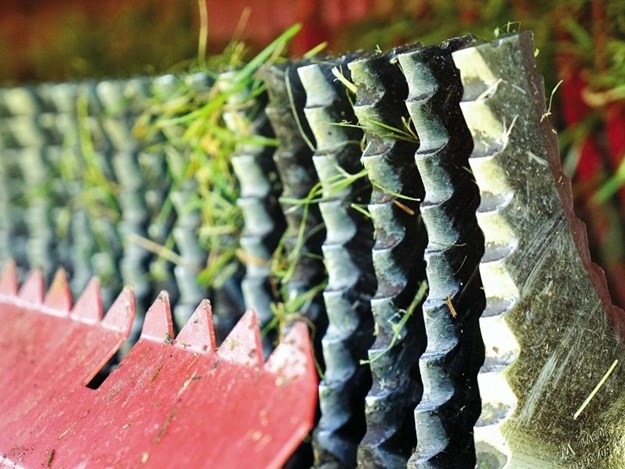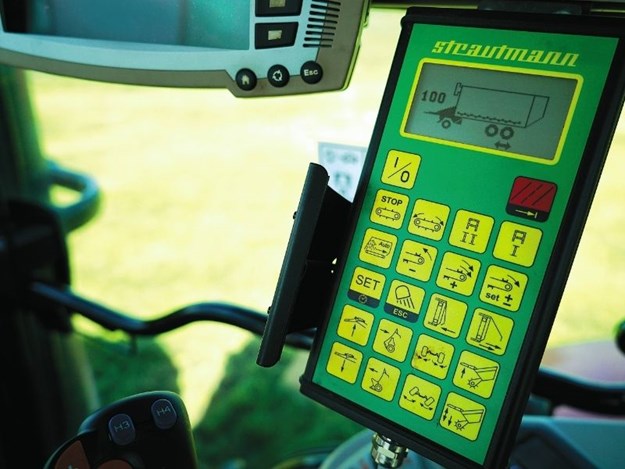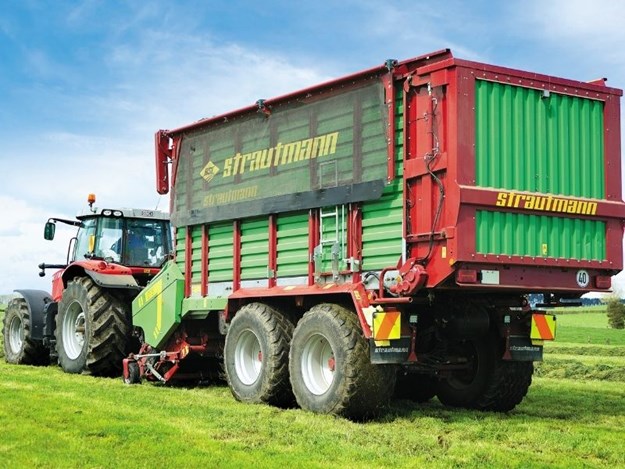One of the jewels in the Strautmann crown is the impressive new Giga-Vitesse CFS 3602, which got the Mark Fouhy treatment over the ditch New Zealand
 |
|
We got a taste of the impressive new Giga-Vitesse CFS 3602 loader wagon from Strautmann
|
With endless pressure on farmers and contractors to maximise efficiencies, there’s also increasing demand for high-performing silage wagons to continuously perform, evolve, and prove their cost-effectiveness. This is all good news to the family behind Strautmann Hopkins Ltd in New Zealand, for the Strautmann range of wagons truly are cutting edge.
As one of the key players in the loader wagon business, Strautmann produce wagons for bulk silage harvesting, as well as specialised machines for zero grazing (cut and carry) for dairy goat and sheep milking operations.
As well as wagons, Strautmann also produce a range of solid muck spreaders, loader attachments, and mixer wagons.
However, one of the jewels in their crown is the impressive new Giga-Vitesse CFS 3602, which I got to spend the day with near the foothills of Te Aroha.
Having done a little research, it’s clear to see that rather than sitting back and accepting that they are ticking along successfully, in Germany – the home of Strautmann – the foot is firmly on the throttle in terms of Research and Development; some of these features are part of the Giga-Vitesse 3602, which we’re taking a look at here, and more will be unveiled on the Strautmann Magnon 42-52 cubic meter wagons (but we’ll have to wait until 2021 before these reach our shores).
.jpg) |
|
The Strautmann Giga-Vitesse CFS 3602 is built for work
|
Put to the test
Something of a success story in these trying times of finding skilled staff to get vital agricultural work done, Rex Mikklesen is the owner of the Strautmann Giga-Vitesse CFS 3602. Rex has been in the farming game for some decades, and like many farmers enjoys operating gear himself.
He has chosen Strautmann wagons for some time, initially to get silage done on his own property, and then (perhaps given the reliability of his Strautmann gear and possibly to help justify the capital outlay) also offering his services to other farmers around the Tatuanui/Morrinsville area.
Working in with a mate with another loader wagon, and another contractor for stacking duties, together they can offer a cost-effective service and a useful alternative to self-propelled forage harvester crews.
On the day we caught up with Rex, he was on a small job of approximately 20 hectares. While this could easily have been managed by Rex and his wagon alone, the two mates enjoy working together and it probably saves the farmers cost in the long-run, with less time for the stacker waiting on the next load.
With a twin rotor rake pulling in three rows of grass in front of the loader wagons, the rows being fed through the pickup weren’t huge and were no trouble for the 2.25-metre wide pickup and feed rotor (which I will cover in more depth later). I reckon the rows would be similar to what you’d put in front of a round baler, and Rex and his Strautmann were cruising, with the Massey Fergusson 7622 hardly working at all.
I’d estimate ground speed on this job to be similar to that of a self-propelled harvester but at the lower cost of running a tractor and bin trailer. I’d be interested to see what size rows you could stack in front of the 3602 loader wagon, for example, a heavy crop pulled in with a quad rotor. Even then I wonder if the forager would manage to be miles ahead in that situation.
However, back to our test: with 44 knives running across the 2.1-metre rotor, giving a theoretical cut length of 35mm, as well as being the first cut, the grass harvested should be rocket fuel feed for later in the season when required.
Manoeuvrability was an area where the big wagon impressed me. Being able to turn back on to the next row is far more efficient than skipping rows across a paddock. I put this down to the rear steering axle which hugely aids manoeuvrability, which comes in extremely handy getting through gateways and down farm laneways.
 |
|
New rotor design with side augers to better feed crop through rotor and knives
|
Rotors and cutting unit
Clearly, much of thought has gone into this area and it’s where a lot of the R&D dollars have been spent. The innovations here really set Strautamnn apart from its competitors.
Camless pickup ensures the gentle picking up of grass and dispersal of swathe. Tine plates welded on the rotor ensure a uniform scissor-type cut and the small distance between the rotor tines and knives ensures an exact cut while requiring little power.
While at first glance you may not notice, closer inspection shows that where paint has rubbed off the pickup bands, they are not black shiny steel.
These are actually Teflon, which has a number of benefits:
- Pickup runs quieter, with no steel on steel or any bent tines
- Should you hit rough ground, which would otherwise bend steel bands, these Teflon bands are designed to have flex so will just spring back into place
- When it’s time to change tines, getting the bands back on is not going to be the usual headache for these reasons: they won’t be bent out of shape and they have flex to help line bolts back up
The steel roller behind the pickup also helps avoid damage. As the max overall width of the machine is only 2.81 metres, there’s no need to fold in pickup wheels to go on the road or fit through gateways.
Six rows of tines are mounted in a V-shape, with two crop press rollers feeding the forage evenly into the rotor. The feed rotor has eight helical tine rows, and at 1.6 metres wide on the outside, there are 25cm augers, a little like a round baler, to feed the rotor. The knives work between the tines of the rotor giving a scissor-type cutting action and with a bank of 44 knives give a cut length of 35mm.
Protection of the knife and rotor will kick out should the knife strike a hard object, minimising the chances of damage to either knives or rotor. After 12 months, Rex is still on the first side of the double-sided knives. Life expectancy depends on workload, forage processed, environmental, and other factors.
Strautmann’s patented quick release system is a genius of design and effectively works to keep knives sharp, ensuring quality performance.
 |
|
Double sided knives out, hydraulically
|
Continuous Flow System
The unique Continuous Flow System (CFS) Strautmann uses in these wagons incorporates a roller to feed the crop from the pickup into the rotor, avoiding a dead spot in the pickup and allowing feed to flow smoothly through the rotor and knives on up into the bin, giving good compaction, with minimal moving parts and associated wear and tear over the life of the machine.
The efficiency of this system means a smaller horsepower requirement to run the wagon – 145hp minimum. Rex was running a 220hp machine, which would probably handle the weight of the machine and a full load slightly better if you were doing bigger haulage jobs.
Controls
A number of cab controls are available to suit various operations, and Rex has opted for the basic Field Operator 120 Terminal, which Strautmann have been successfully using for some time. Controls are touchpad, with lighting down the side to see so you can still see what you’re doing once the sun goes down. It’s small thoughtful touches like this that hint at the real hands-on understanding from the designers, of how operators work and what their needs may be.
There’s no problem with the functionality of this system, and familiarity with older wagons may suit some operators. However, Strautmann also offer a slightly higher spec with the 130 Terminal with colour screen, and there’s the option of running through the tractors Isobus screen if you want minimal cab clutter with extra screens.
Rex has fitted after-market cameras inside the rear door so he can see how the load is progressing, and also under the back of the machine. This is handy in terms of being able to see exactly what you’re doing at the pit and also to avoid troughs, etc., lurking behind the wagon when backing up.
Power-wise, basic wagon operation is controlled through the hydraulic load sensing system of the tractor: floor, pickup, rear door, raise, and lower. PTO operates the pickup, CFS roller, and rotor and rear beaters (if fitted). Optional extras on Rex’s machine include hydraulic suspension, hydraulic cover, and opening front panel, which operates off extra hydraulic banks. If you’re going to invest in a loader wagon, it seems like a good idea to add the opening upper front panel to allow it to be used for maize harvesting as well.
 |
|
Strautmann is keeping it simple with the easy-to-use in-cab controller
|
Construction
Globally, Strautmann are known for producing a quality product. For me, the definition of quality comes down to the longevity or lifespan of a machine, and this means quality construction, components, and service. Strautmann ticks all these boxes.
While Strautmann may not be the cheapest option out there when it comes to loader wagons, many a farmer and contractor have learned to their frustration the folly of trying to save initial investment dollars on a machine. Inferior quality reduces work efficiency and increases workshop time.
There’s a reason you see so many Strautmann loader wagons operating around the country, and I think it has a lot to do with the overall build quality and innovation of these machines, and the fact they have plenty of genuine parts in stock (due to the high number of machines operating), with experienced back-up teams in both the North and South Islands.
Although the Strautmann brand is German-made, there’s a long history with the Hopkins family here in New Zealand, which prides itself on offering top-notch service and can complete full machine refurbishments to give a near-new machine, when others might be ready for retirement.
This test machine comes with a galvanised chassis, something I would recommend ticking the box on if ordering a new machine. The extra expense is well worth it, given the corrosive nature of both grass and maize silage. Differing floor options are also available on various machines. Split floor chains are standard but may have either bolted on steel bars or welded to conveyor chain, with choice of wooden (like our test machine), steel or Teflon floors.Different hitch types K80 ball or standard ring hitch are available depending on individual requirements.
Safety
Operating large and expensive gear safely is crucial, and with this in mind, it’s good to see all the over width panels and flashing rear orange lights as standard. Dual safety chains are there to comply with New Zealand road regulations, as well as rope break away and hydraulic trailer brakes.
Optional hydraulic suspension, as fitted to the test machine, gives an extra two-tonne axle rating (20 tonnes) as well as improved comfort when operating at higher speeds (50km/hr). Regulations around secure load means silage loads must be covered or they can be deemed as an unsecured load, potentially incurring a $600 fine. Covers aren’t fitted as standard equipment from the factory yet but are another addition worth adding to the list of inclusions.
Strautmann in New Zealand
The Strautmann brand was originally bought to New Zealand by the Hopkins family in the Manawatu, and now 37 years later, Strautmann Hopkins remains a family-owned business, with generations continuing the traditions of excellence.
With Waikato being such a strong area for the brand, Strautmann Hopkins Waikato Limited has recently been set up, which sees Stan and Fiona Knight at Te Aroha Tractors partnering with Strautmann Hopkins. The South Island is equally well represented, with an experienced team at D&K Engineering in Waimate, headed up by Daryl Brown.
 |
|
The Strautmann brand was originally bought to New Zealand by the Hopkins family in the Manawatu
|
Summary
Having a good product is one thing, but continually aiming to improve, while striving to be the best is another – and this has always been a key driver for Strautmann.
The new features on this Giga-Vitesse CFS 3602 are truly impressive and I’m looking forward to seeing the new Magnon on our shores, which boasts some revolutionary pickup features, such as the Flexi-Tyne plastic pick up tynes, also available on request on other models. Although most of these models are targeted at contractors, smaller machines to do your own silage are still available (as well as mixer and muck spreaders).
So, are loader wagons are thing of the past? With these next-generation Strautmann machines, I say no, and they will still fill the needs of many contractors and farmers harvesting and hauling needs for years to come.
Photography: Mark Fouhy, Justin Bennett

